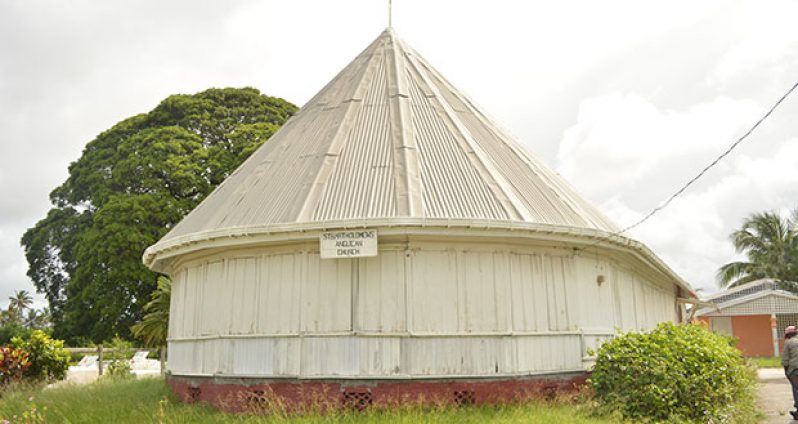LOCATED in the quiet but cheerful village of Queenstown, on the Essequibo Coast, the existence of St Bartholomew Anglican Church stretches back to the dark era of slavery, over a century ago.Originally a coffee storage house, the building is believed to have first been constructed by slave labour in the 16th century, but following the abolition of slavery, was converted into a church by the White planter who had owned the plantation where it sat.

There is no record showing exactly when the building was consecrated a church, but some church elders believe that it happened around 1830. Unique in shape, the architecture was modified to somewhat resemble the early ships that brought the slaves to the West Indies from the African coast after it was converted into a church. Though the building was renovated several times over the years, its architecture was never changed.
According to church member Winston Christiani, 73, there have been several attempts to modify the building’s architecture, but most church members have rejected these proposals. Thus to this day, and for a long time to come — if that time will ever come -– the building has retained the design of its construction at time of consecration.
The first church to be constructed in Queenstown, the building was named after St Bartholomew, one of the 12 disciples of the Lord and Saviour Jesus Christ. Bartholomew has been identified with Nathanael, who appears in the Gospel according to John as being introduced to Christ by Philip (who would also become an apostle).
In the early days, the church was presided over by European priests, but as time went by, this culture changed and folks of African, Indian, and even Indigenous ancestry were appointed as priests, once trained in Theology.
Queenstown residents worship at St Bartholomew Anglican Church every Sunday, and according to Christiani, Easter and Old Year’s Night services attract the largest congregation.
A RELIGIOUS PEOPLE
Queenstown residents are a religious people, and over the years, several Christian denominations established a presence in the village. Aside from the Anglicans, there are today Methodists, Presbyterians, Seven-Day Adventists and members of the Full Gospel Fellowship churches.
While the church is doing well, Christiani told the Guyana Chronicle, it has, in the past few years, lost some of its members to the Full Gospel Fellowship Church; and this is probably due to the way that church conducts its prayer services.
Services at the Full Gospel Fellowship Church are lively, with members singing and dancing, compared to the simple way services are conducted at the St Bartholomew Anglican Church.
Apart from the Christian churches, there is a Temple and a Masjid in Queenstown, the largest village in all of Guyana.
At the time of its founding in 1841, Queenstown, named after Queen Victoria, was a Black village; but today it has diversified, due mainly to interracial marriages, Christiani said.
All the sugar factories in the village have disappeared, and the lands used for planting sugarcane have now been given over to rice cultivation.
Queenstown has, from the days of slavery, remained an agriculture-based village, with residents engaged in cultivation of ground provision, coconut and cash crops.

Christiani related that in his days as a boy, practically every household had a farmer, with a vast majority of them planting cassava, which was used to make cassava bread. It used to be sold widely on the coast, until the arrival of wheaten flour. This caused the cassava bread business to decline, as villagers opted for wheaten flour, and eventually, many sought occupations other than farming. Some went into the bauxite and sugar industries, and learnt the mechanic trade, while others chose careers in teaching, the Police Force, and other public service disciplines.
Former Deputy Bank of Guyana Governor, Clarence Ellis, is a resident of Queenstown, Christiani told this publication.
LIFE HAS CHANGED
Christiani said that, over the years, life in Queenstown has changed considerably. He pointed out that some of the old customs have died natural deaths and are hardly even spoken about today.
The church elder related that, growing up, his parents and grandparents had regaled him with stories of Moon Gazers, Mermaids and Baccoos, but he has never encountered any of those creatures. However, Christini said, he knows of the Comfa drummers and Comfa priests, who were spiritualists with uncanny abilities.
The Comfa priest and his close followers, Christini said, used to be consulted when a family was going through difficulties or when there was a major occasion in the family.
“The priest and his men, along with the person who consulted the priest, used to go to the burial ground of the person’s father/mother or grandfather/ grandmother and invoke them, asking for guidance to overcome their troubles. From what I was told, it used to be a frightening experience, but all the persons going to the burial ground were prepared for what was to come. I was told that when the spirit was awakened, it groans and the persons around would feel the vibrations in the ground.
“The priest and his men, I was told, would put to the spirit the questions of the persons seeking the invocation, and they spoke in ‘tongues’. If a family had a major court matter, the ancestor spirt was contacted. If there was a wedding, the spirit was contacted also, to have a presence at the ceremony so as to ensure all goes well,” he said.
In those days, Christiani said, there was no electricity and people used to be very afraid of burial grounds; and if someone were to say “I will send my grandfather on you”, the hearer had valid reason to worry, because the person might go to consult the Comfa priest to have him cast a spell on the hearer.
These things, the church elder said, no longer exist today; and young people in the village are not fearful of the burial ground, as their grandparents were.
“Today, some of them play on the tombs in the burial ground; some gamble on them; some smoke, and some do other unholy things,” Christiani said.
And children today regard jumbie stories as jokes, “thanks to electricity, technology and this enlightened age”, he said.



.jpg)










